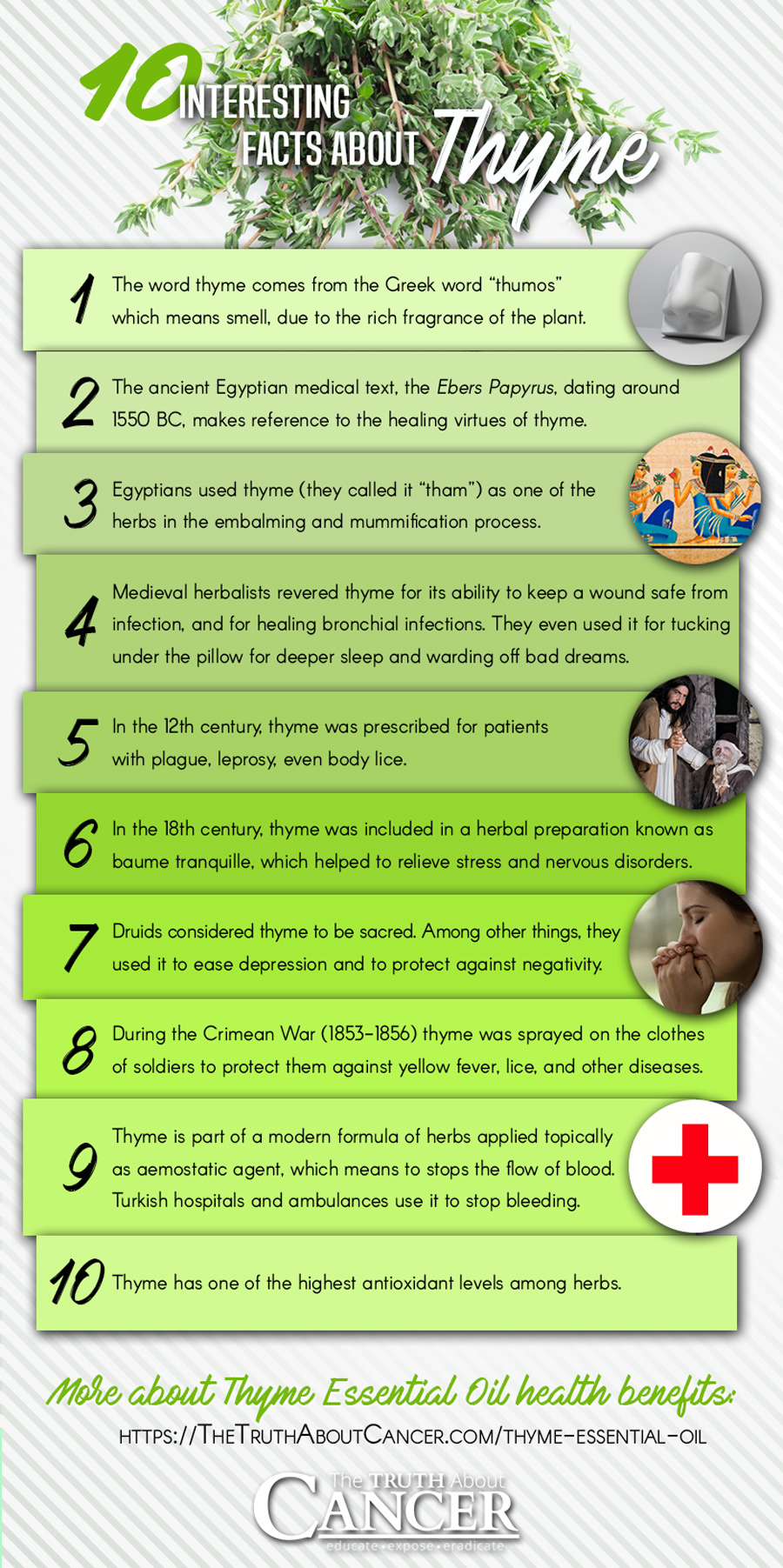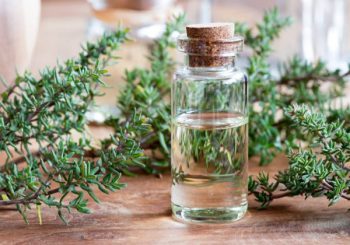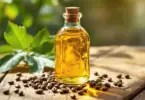By Ty Bollinger
Guest writer for Wake Up World
Thyme (Thymus vulgaris) has a fascinating and long history of use. If you were a knight going off to fight in the Crusades in the 11th and 12th centuries, your lady would have given you a scarf with an embroidered sprig of thyme upon it. Thyme was considered to give courage to its wearer even by the ancient Greeks and Romans.
Now, modern scientists use thyme mixed with special fats to create nanoparticles that give a compound found in thyme more killing power against cancer cells!
[pro_ad_display_adzone id=”110028″]
In our modern world, thyme is a popular herb in the kitchen. It’s known to be full of potent phytochemicals (naturally occurring plant-based chemicals), vitamins, minerals, and antioxidants. Thyme is a great source of vitamins C, A, B2, B6, and B9. It also contains the minerals iron, copper, calcium, manganese, phosphorus, potassium, and zinc. There are over 300 varieties of thyme and at least 20 different chemotypes of thyme (see more on chemotypes below).
Did You Know? 10 Interesting Facts About Thyme
- The word thyme comes from the Greek word “thumos” which means smell, due to the rich fragrance of the plant.
- The ancient Egyptian medical text, the Ebers Papyrus, dating around 1550 BC, makes reference to the healing virtues of thyme.
- Egyptians used thyme (they called it “tham”) as one of the herbs in the embalming and mummification process.
- Medieval herbalists revered thyme for its ability to keep a wound safe from infection, and for healing bronchial infections. They even used it for tucking under the pillow for deeper sleep and warding off bad dreams.
- Druids considered thyme to be sacred. Among other things, they used it to ease depression and to protect against negativity.
- In the 12th century, Hildegard of Bingen, a German abbess, herbalist, music composer, writer, and visionary, prescribed thyme for her patients with plague, leprosy, even body lice. As it turns out, she was 100 percent correct in doing so!
- In the 18th century, thyme was included in a herbal preparation known as baume tranquille, which helped to relieve stress and nervous disorders.
- During the Crimean War (1853-1856) thyme was sprayed on the clothes of soldiers to protect them against yellow fever, lice, and other diseases.
- Thyme is part of a modern formula of herbs applied topically as a hemostatic agent, which means it stops the flow of blood. Called the Ankaferd hemostat, Turkish hospitals and ambulances use it to stop bleeding. It is sometimes used in controlled clinical trials and consists of standardized plant extracts from thyme, licorice, galangal, common nettle, and grapevine. (See below under “Research on Thyme” as to how it is also being used against melanoma).
- Thyme has one of the highest antioxidant levels among herbs.

The Different Chemotypes Found in Thyme Essential Oil
Studies performed at the Department of Chemistry, University of Alabama at Huntsville, and reported in the journal Foods in 2016, revealed that of 85 samples of thyme essential oil investigated, at least 20 chemotypes of thyme oil exist. So what is a chemotype?
A chemotype is a way of describing a plant’s chemical profile with specificity as to predominant phytochemicals (natural, plant-derived chemicals). Plants have differing chemical profiles for a variety of reasons. They might grow in different regions, or at different altitudes, under varying growing conditions and other environmental factors. This gives the plants a different array of phytochemicals. In other words, a thyme plant growing in Idaho may look the same as a thyme plant growing in Spain, it might belong to the same genus and species, but the two can have a very different phytochemical content.
If you see a thyme plant with the title thymus vulgaris ct thymol, it means that the chemotype of this thyme is thymol and thymol is the most abundant phytochemical. It will also have slightly different therapeutic properties from, say, thymus vulgaris ct linalool, due to the presence of varying amounts of phytochemicals in the plants. Unfortunately, many essential oil makers often do not denote from which plant chemotype their oil is derived. 1
The most common thyme chemotypes, and the conditions for which they have proven helpful, are:
- Thymus vulgaris ct thymol – Between 60-70 percent thymol, this chemotype has strong antiseptic properties. It has a high level of antioxidants, with strong anti-inflammatory and pain-relieving benefits.
- Thymus vulgaris ct linalool – One of the gentlest of thyme chemotypes, it commonly grows at high altitudes and has potent antifungal and anti-parasitic properties.
- Thymus vulgaris ct carvacrol – Between 30-80 percent carvacrol (depending on when it is harvested), it has also has potent anti-inflammatory, analgesic (pain relieving) and antioxidant properties.
- Thymus vulgaris ct 1,8 cineole – Is 80-90 percent cineole, with an interesting array of benefits. It is a good expectorant (phlegm releaser), diuretic (increases the expulsion of urine), and analgesic properties.
- Thymus vulgaris ct thujanol – About 50 percent thujanol, this chemotype is known to support the immune system. It is found mainly in the wild, known commonly as Sweet Thyme.
- The Potent Phytochemicals in Thyme
The most abundant phytochemicals in thyme include thymol, carvacrol, linalool, 1,8 cineole, thujanol, myrcene, alpha-pinene, beta-caryophyllene, p-cymene, camphor, camphene, geraniol, geranyl acetate, terpinene-4-ol, and the flavonoids apigenin, naringenin, luteolin, and thymonin. These phytochemicals are responsible for the potency of thyme and for its medicinal uses.
Historical Uses for Thyme
Historically, thyme has been revered for its ability to increase circulation. It was also used as a diuretic and as an antibacterial ? not that the ancients understood about germs and bacteria, but they observed its ability to help heal wounds, cuts, bruises, insect bites, sprains and other injuries.
Thyme has also been used for treating respiratory problems and as an antifungal in the treatment of athlete’s foot and candida (see more on candida below).
Thyme has a high concentration of iron, and herbalists have found that it helped feed the blood in cases of blood loss. It was used for women’s conditions, including painful menstruation, irregular periods, and menopausal side effects.
Thymol, one of the most abundant phytochemicals found in thyme, has long been one of the ingredients in some of the most popular antiseptic, antibacterial mouthwash formulations.
11+ Benefits Researchers Have Discovered About Thyme and Thyme Essential Oil
1. Antibacterial, Antimicrobial, Antifungal
A 2004 study investigated the effects of several essential oils against the fungus Candida albicans. Included in the study were six chemotypes of thymus vulgaris. Researchers stated that thymus vulgaris ct thymol exhibited “the most efficiency” against C albicans. When used in combination with the antifungal drug amphotericin B, thymus vulgaris ct thymol increased the anti-fungal action of amphotericin B. 2
Pakistani researchers in 2017 evaluated thyme against four common pathogenic bacterial strains: Bacillus subtilis, Staphylococcus aureus, Pasteurella multocida, and Escherichia coli. It was also tested against four fungal strains: Aspergillus flavus, Rhizopus solani, Aspergillus niger, and Alternaria alternate. Thyme successfully inhibited all of them. 3
2. Anti-cancer
1998 American research found that of 150 herbs and plants tested for their ability to compete with estradiol and progesterone binding sites on human breast cancer cells, thyme was one of the best herbs tested. For those whose breast cancer cells exhibit estrogen and progesterone receptors (termed ER+ and PR+) oncologists almost always prescribe hormone blocking medications that come with a long list of onerous side effects. The researchers in this study found thyme to be one of the top six herbs that displayed the best ability to bind to both estrogen and progesterone receptors. 4 Scientists have discovered that these natural herbs exert a much weaker influence in the body than the body’s own estrogen and progesterone.
In 2010, Chinese researchers investigated several essential oils for both their antibacterial (see discussion below under Skin Conditions) and anti-cancer activity. Researchers found that thyme oil had the best ability to inhibit MCF-7 breast cancer cells ? it had a 97 percent kill rate. MCF-7 cells are estrogen-receptor positive, progesterone-receptor positive, HER2 negative infiltrating ductal carcinoma cells with metastases. Researchers found that thyme essential oil also showed strong cytotoxic (toxic to cancer cells) properties against PC-3 prostate cancer cells and A549 lung cancer cells. 5
A 2011 German study found thyme inhibited the growth of head and neck squamous cell carcinoma. Researchers advised that “Genes involved in the cell cycle, cell death and cancer were involved in the cytotoxic activity of thyme essential oil at the transcriptional level.” 6
A 2014 study on the antioxidant, anti-inflammatory and anti-proliferative properties of various essential oils found thyme oil exhibited some of the most beneficial actions. Thyme was the best free radical scavenger, the most effective against the degradation of fats, and had the best ability to halt the spread of acute monocytic leukemia cells. 7
A 2016 Chinese in vitro (test tube) study on the effects of carvacrol, one of the phytochemicals in thyme oil, on human oral squamous cell carcinoma (tongue cancer) had interesting results. Carvacrol significantly inhibited the migration and invasion of these cells. Researchers stated “carvacrol plays critical roles in cell cycle, cell invasion, and metastasis signaling pathways.” 8
2017 Turkish research discovered thyme (as part of a topical herbal complex known as Ankaferd hemostat, discussed above under Interesting Facts) had potent inhibitory properties against melanoma cells. 9
A brand-new 2017 study performed in Argentina investigated the phytochemical linalool from thyme oil. Aware of the fact that linalool can be poorly absorbed, to make it more bioavailable these researchers created a nanoparticle by encapsulating the linalool in several differing lipid (fat) outer layers. They then tested the nanoparticles against several different cancer cell lines. The in vitro tests were done with hepatocellular carcinoma (liver cancer) and lung adenocarcinoma (lung cancer). Compared with free linalool, the nanoparticles had a higher inhibitory effect on these cells. 10
3. Anti-inflammatory
A 2010 Japanese study found one of the particular ways in which carvacrol suppresses inflammation: it inhibits the activity of an enzyme known as cyclooxygenase-2 (COX-2), which plays a key role in inflammation. Carvacrol also activates certain transcription factors known as PPARs (peroxisome proliferator-activated receptors), involved in the control of COX-2. 11
Brazilian research reported in 2016 also found that carvacrol had anti-inflammatory action in mice with intestinal mucositis, 12 an inflammatory condition affecting the inner lining of the intestines. It is often the result of cancer surgery, chemotherapy, and/or radiation.
A Chinese animal study found that carvacrol inhibited the inflammatory response and had a neuroprotective effect in animals with cerebral ischemia injuries. This means that the brains of the animals had insufficient blood flow. This often leads to insufficient oxygen to the brain and results in the death of brain tissue. With its anti-inflammatory action, carvacrol helped to protect brain tissue. 13
4. Antinociceptive (Pain Blocking)
Antinociception is a little different from analgesia. While analgesics ease the sensation of pain, a antinociceptive substance actually blocks the detection of a painful stimulus by the body’s sensory nerves. Some believe that in comparison with using systemic narcotic pain relievers like morphine, antinociception has a longer duration. 14 In 2012, Brazilian researchers studying the effects of carvacrol on mice discovered it had “significant” antinociceptive activity. 15
5. Antiparasitic
2015 Egyptian research looked at both myrrh and thyme against a parasite known as Trichinella spiralis. This parasitic worm can be found in animals that eat meat and causes a disease called trichinosis (also known as trichinellosis). Humans contract trichinosis by eating the raw or undercooked meat of animals infected with Trichinella larvae. Trichinosis can be a serious and debilitating disease, and the standard drug therapy does not work well. The researchers in this study found that both myrrh and thyme extracts, given orally, were safe and “highly effective” against both larvae and adult T spiralis infected mice. 16
Research reported in 2016 by Argentinian scientists found that carvacrol and thymol from thyme essential oil were potent against the parasite Echinococcus granulosus, also known as hydatid worm, hyper tapeworm, or dog tapeworm. 17
Another 2016 study investigated the effects of thyme essential oil against Pediculus humanus capitis, or the human head louse. Thyme oil exhibited potent toxicity against both adult lice and their eggs and did not cause any skin side effects. 18
6. Arthritis
Early stage joint Dutch/Italian research reported in 2012 found that carvacrol may have applications for rheumatoid arthritis and other chronic inflammatory diseases. Because of the high dosage of carvacrol that would be required for an effective dose, oral administration was not considered to be the best approach because of its strong antibacterial properties. Researchers were concerned that high doses of carvacrol could negatively affect the intestinal flora. In this study (done on mice), scientists treated special cells from the bone marrow with a combination of carvacrol and thermal stress which helped to suppress autoimmune arthritis. 19 That is truly thinking out of the box!
A 2014 study done by Portuguese researchers investigated the effects of alpha-pinene, another of thyme’s phytochemicals. They were examining its ability to modulate inflammation and the activity of chondrocytes, the cells involved in producing and maintaining cartilage. They found that alpha-pinene had anti-inflammatory properties. They said thyme was “promising for further studies to determine its potential value as an antiosteoarthritic drug.” 20
7. Detoxifies Aflatoxins
Thyme has been found to be a potent detoxifier of aflatoxins, a form of toxic mold. Aflatoxin molds are produced by certain types of fungi (especially Aspergillus parasiticus and Aspergillus flavus) and are known to form in grains and other foods stored for long periods. Aflatoxins are considered to be carcinogenic (cancer-causing). Aflatoxins B1 and B2 are the most toxic, and scientists have been actively looking for effective ways to get rid of them. 2015 research published in the journal Food Chemistry found that thyme essential oil completely inhibited the growth of Aspergillus flavus and its production of aflatoxins. 21
8. Hair Loss
Although thyme has been used traditionally to combat hair loss, it wasn’t until Scottish researchers released a study in 1998 showing certain essential oils (including thyme) actually do make a difference. Eighty-six study participants with alopecia areata were followed over a 7-month period of time. One group used essential oils of thyme, rosemary, lavender, and cedarwood in a mixture of grapeseed and jojoba oils rubbed into the scalp daily. The control group used only the grapeseed and jojoba oils. Forty-four percent of participants in the group using essential oils showed improvement. 22
9. Insecticidal
Mexican research performed in 2015 investigated the insecticidal properties of several essential oils against Aedes aegypti, the mosquito responsible for spreading yellow fever, dengue fever, West Nile virus, and other tropical diseases. Thyme oil was found to be extremely effective against the larvae of this mosquito. Many such studies exist. 23
Korean researchers in 2017 found thyme to be potent against Pochazia shantungensis, a newly recorded pest wreaking havoc on apple, blueberry, peach, and persimmon trees. 24
10. Skin Conditions
Thyme has been used traditionally for its benefits for oily skin, scars, acne, and slowing the effects of aging in skin.
In 2010, Chinese researchers investigated several essential oils for their activity against the bacterium that causes acne, Propionibacterium acnes. Thyme oil was one of the oils that exhibited the best antibacterial activity against P. acnes ? it was completely eradicated after 5 minutes. 5
Italian research reported in the journal Mutation Research/Genetic Toxicology and Environmental Mutagenesis in 2015 found that thymol protected the skin from the effects of UVA and UVB rays on keratinocyte skin cells. Thymol inhibited the generation of reactive oxygen species in UVA and UVB-irradiated cells, associated with significant damage to cells. Thymol also inhibited DNA damage in the irradiated cells. 25

11. Stress Relief
Thyme contains vitamin B6, which has a direct effect on key neurotransmitters in the brain linked to stress hormones. Many studies have been done on the effects of B vitamins for easing symptoms of stress. Thyme’s high level of antioxidants and thymol have been found to be protective and to increase the percentage of healthy fats in cell membranes. This has a positive effect on the brain and other body tissues.
Thyme also contains an impressive amount of vitamins C and A. Vitamin C plays an important role in stress management. It assists the body to quickly clear cortisol out of the bloodstream. Cortisol is the primary stress hormone that increases in stressful situations. High cortisol levels are known to lead to premature aging, digestive problems, and many other health problems ? including cancer. During times of stress, levels of vitamin A also decline.
Precautions for Using Thyme Essential Oil
Due to its phenol content, thyme can be a hot oil when applied directly to the skin. Be cautious when using thyme oil. Always dilute with an organic carrier oil such as olive, coconut, almond, or jojoba prior to use as it could irritate the skin or nasal membranes.
Never apply essential oils inside ears, anywhere near the eyes, or to other sensitive regions of the body.
It is best not to use thyme oil with infants or children under age 5. Nursing and pregnant woman should also avoid thyme.
If you intend to use thyme essential oil for therapeutic purposes, be aware that essential oil quality varies greatly. Find out whether the supplier of the essential oil brand you wish to use employs organic growing methods, and knows how to properly distill oils. Buy your oils from a trusted source. If the oils are improperly grown or distilled, they may have toxic chemical residues which can be harmful to your health.
It is not recommended that thyme essential oil be utilized for any health condition in lieu of the treatment recommended by your physician. Please work with your doctor, certified aromatherapist, or properly trained health coach when using essential oils for any health concerns.
Sources and References:
- 1. Essential Oil Characterization of Thymus vulgaris from Various Geographical Locations
- 2. Antifungal Effect of Various Essential Oils Against Candida Albicans. Potentiation of Antifungal Action of Amphotericin B by Essential Oil from Thymus Vulgaris
- 3. Evaluation of Phenolic Compounds and Antioxidant and Antimicrobial Activities of Some Common Herbs
- 4. Estrogen and Progestin Bioactivity of Foods, Herbs, and Spices
- 5. Activities of Ten Essential Oils Towards Propionibacterium Acnes and PC-3, A-549 and MCF-7 Cancer Cells
- 6. Cytotoxicity of Thymus Vulgaris Essential Oil Towards Human Oral Cavity Squamous Cell Carcinoma
- 7. Anti-oxidant, Anti-inflammatory and Anti-proliferative Activities of Moroccan Commercial Essential Oils
- 8. Carvacrol Suppresses Proliferation and Invasion in Human Oral Squamous Cell Carcinoma
- 9. Growth Inhibitory Activity of Ankaferd Hemostat on Primary Melanoma Cells and Cell Lines
- 10. Design, Characterization and in Vitro Evaluation of Linalool-loaded Solid Lipid Nanoparticles as Potent Tool in Cancer Therapy
- 11. Carvacrol, a Component of Thyme Oil, Activates PPAR Alpha and Gamma and Suppresses COX-2 Expression
- 12. Carvacrol Reduces Irinotecan-induced Intestinal Mucositis Through Inhibition of Inflammation and Oxidative Damage via TRPA1 Receptor Activation
- 13. Carvacrol Exerts Neuroprotective Effects Via Suppression of the Inflammatory Response in Middle Cerebral Artery Occlusion Rats
- 14. Neuroscience Online Chapter 6: Pain Principles
- 15. Antinociceptive Activity of Carvacrol (5-isopropyl-2-methylphenol) in Mice
- 16. Effect of Myrrh and Thyme on Trichinella Spiralis Enteral and Parenteral Phases with Inducible Nitric Oxide Expression in Mice
- 17. In Vitro and in Vivo Efficacy of Carvacrol Against Echinococcus Granulosus
- 18. The Potential Application of Plant Essential Oils to Control Pediculus humanus capitis (Anoplura: Pediculidae)
- 19. Tolerogenic Dendritic Cells That Inhibit Autoimmune Arthritis Can Be Induced by a Combination of Carvacrol and Thermal Stress
- 20. Anti-inflammatory and Chondroprotective Activity of (+)-a-pinene: Structural and Enantiomeric Selectivity
- 21. Antifungal Properties and Inhibitory Effects upon Aflatoxin Production of Thymus Vulgaris L. by Aspergillus Flavus Link
- 22. Randomized Trial of Aromatherapy. Successful Treatment for Alopecia Areata
- 23. Essential oils from Zanthoxylum fagara Wild Lime, Ruta chalepensis L. and Thymus vulgaris L.: Composition and Activity Against Aedes aegypti Larvae
- 24. Insecticidal Toxicities of Carvacrol and Thymol Derived from Thymus Vulgaris Lin. Against Pochazia Shantungensis Chou & Lu., Newly Recorded Pest
- 25. Thymol and Thymus Vulgaris L. Activity Against UVA- and UVB-induced Damage in NCTC 2544 Cell Line
About the author:
 Ty Bollinger is a health freedom advocate, cancer researcher, former competitive bodybuilder and author. After losing several family members to cancer, he refused to accept the notion that chemotherapy, radiation, and surgery were the most effective treatments available for cancer patients. He began a quest to learn all he possibly could about alternative cancer treatments and the medical industry. What he uncovered was shocking. There is ample evidence to support the allegation that the “war on cancer” is largely a fraud and that multinational pharmaceutical companies are “running the show.” Ty has now made it his life mission to share the most remarkable discovery he made on his quest: the vast majority of all diseases, including cancer, can be easily prevented and even cured without drugs or surgery.
Ty Bollinger is a health freedom advocate, cancer researcher, former competitive bodybuilder and author. After losing several family members to cancer, he refused to accept the notion that chemotherapy, radiation, and surgery were the most effective treatments available for cancer patients. He began a quest to learn all he possibly could about alternative cancer treatments and the medical industry. What he uncovered was shocking. There is ample evidence to support the allegation that the “war on cancer” is largely a fraud and that multinational pharmaceutical companies are “running the show.” Ty has now made it his life mission to share the most remarkable discovery he made on his quest: the vast majority of all diseases, including cancer, can be easily prevented and even cured without drugs or surgery.
For more information, visit:
[pro_ad_display_adzone id=”110027″]







